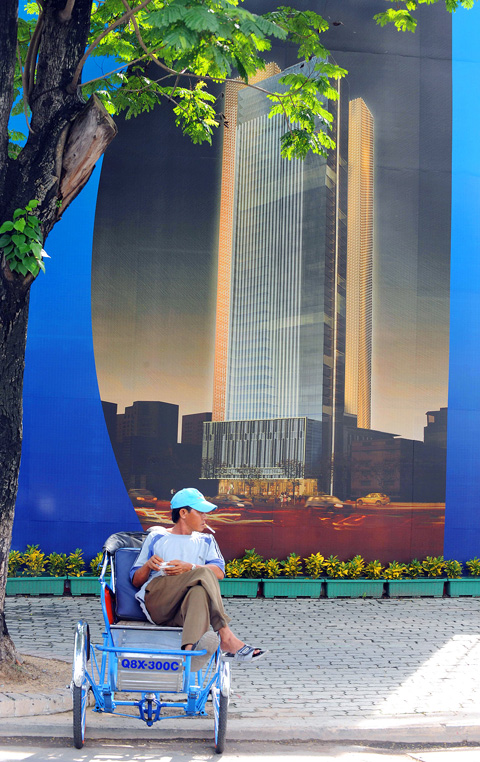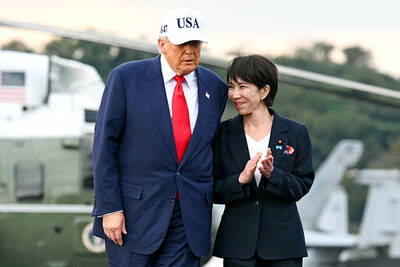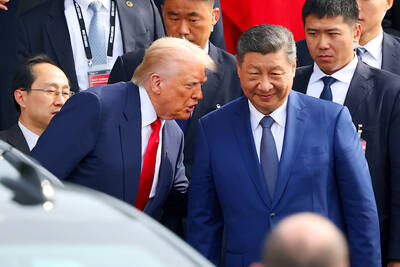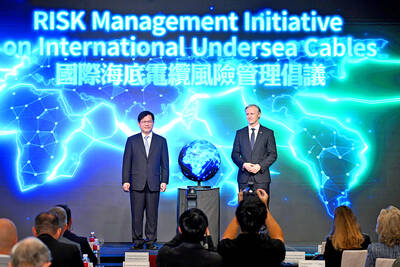Vietnam’s economy, until recently a darling of foreign investors, has overheated and may be sliding into a boom-and-bust cycle that could require IMF-style assistance, analysts say.
The economy widely hailed last year as Asia’s next tiger has been battered by double-digit inflation, a ballooning trade gap, a tanked stock market and worries about the currency and banking sector.
Credit rating agencies Standard & Poor’s, Fitch and Moody’s and several investment banks have revised downward their outlooks for Vietnam at a time when the specter of a US recession could spell global trouble.

PHOTO: AFP
Aseambankers Research said: “The worst-case scenario would be for Vietnam to suffer massive capital flight, triggering a balance of payment crisis and forcing the country to go to the International Monetary Fund for help.”
Analyst Adam Le Mesurier wrote for consultancy DSG Asia that “an ‘IMF-program- style’ policy response will be needed within six months,” including monetary and fiscal tightening and a dong currency devaluation.”
Many investors and donors in Vietnam remain upbeat about the market of 86 million, pointing to strong exports — including food and oil — investment inflows, growing tourism and the potential of its young workforce.
“It’s too easy to get excited and claim that Vietnam has gone from poster child to problem child,” EU chief country representative Sean Doyle said. “But I’m not sure it’s very wise and very balanced ... Vietnam, if it can keep steady, stick with the right policies, will be attractive.”
Nonetheless, the turnaround in investor perception has been stunning.
Communist Vietnam’s entry into the WTO last year fuelled enthusiasm for the low-wage “mini-China,” bringing an influx of foreign cash.
Domestic investors gambled on a sky-rocketing stock exchange, the government went on a spending spree and banks lent freely, fuelling rapid credit growth.
The wheels started to come off about half a year ago, when inflation hit double digits as the economy tried to digest US$6 billion in foreign direct investment (FDI) disbursed last year, or 8.4 percent of GDP.
Since the start of the year, prices have galloped, driven by global food and energy costs, to 25 percent year-on-year inflation last month. Wage demands sparked 300 labor strikes in the first quarter alone.
“The wage-price spiral that appears to be beginning, if it becomes embedded, could make matters much worse,” said an HSBC report that predicted a rise to 30 percent inflation amid hoarding of commodities.
Another alarm bell sounded when surging imports drove the trade deficit to US$14.4 billion last month, compared to US$12 billion for all of last year.
The stock market has tumbled amid tighter credit and falling investor confidence, turning from the world’s best to worst performing bourse. Last week it crashed below 400 points, from its high of over 1,100 last March.
Many investors have bought gold or offloaded value-losing dong for greenbacks, briefly sending the black market rate in Vietnam to 18,500 to the dollar last week, against the official rate of around 16,000.
Standard Chartered Bank said recently that the “Vietnamese dong has come under downward pressure, and such pressure is likely to persist until solid improvement is seen in the trade balance.”
Some observers now fear a banking crisis amid tighter liquidity, depositor-flight and non-performing loans.
“Urgent action is required in the financial sector,” said Michael Pease, chairman of the Vietnam Business Forum. “Vulnerability of some financial institutions threatens not just the domestic financial sector but also the confidence of foreign investors.”
Vietnam’s government — which has adopted a fight-inflation-first strategy and pledged other economic fixes — has lowered its economic growth target for this year to 7 percent from last year’s blistering 8.5 percent.
IMF country chief Benedict Bingham has suggested Vietnam cool its “overheated” economy with higher interest rates and public spending cuts, freeing up of the exchange rate and accelerated reforms of its state-owned enterprises.
While Bingham said the IMF was “encouraged” by government plans to fix the economy, he called for “a concrete and convincing policy package that will bolster investor confidence and restore macroeconomic stability.”

Japanese Prime Minister Sanae Takaichi yesterday lavished US President Donald Trump with praise and vows of a “golden age” of ties on his visit to Tokyo, before inking a deal with Washington aimed at securing critical minerals. Takaichi — Japan’s first female prime minister — pulled out all the stops for Trump in her opening test on the international stage and even announced that she would nominate him for a Nobel Peace Prize, the White House said. Trump has become increasingly focused on the Nobel since his return to power in January and claims to have ended several conflicts around the world,

UKRAINE, NVIDIA: The US leader said the subject of Russia’s war had come up ‘very strongly,’ while Jenson Huang was hoping that the conversation was good Chinese President Xi Jinping (習近平) and US President Donald Trump had differing takes following their meeting in Busan, South Korea, yesterday. Xi said that the two sides should complete follow-up work as soon as possible to deliver tangible results that would provide “peace of mind” to China, the US and the rest of the world, while Trump hailed the “great success” of the talks. The two discussed trade, including a deal to reduce tariffs slapped on China for its role in the fentanyl trade, as well as cooperation in ending the war in Ukraine, among other issues, but they did not mention

REASSURANCE: The US said Taiwan’s interests would not be harmed during the talk and that it remains steadfast in its support for the nation, the foreign minister said US President Donald Trump on Friday said he would bring up Taiwan with Chinese President Xi Jinping (習近平) during a meeting on the sidelines of the APEC Summit in South Korea this week. “I will be talking about Taiwan [with Xi],” Trump told reporters before he departed for his trip to Asia, adding that he had “a lot of respect for Taiwan.” “We have a lot to talk about with President Xi, and he has a lot to talk about with us. I think we’ll have a good meeting,” Trump said. Taiwan has long been a contentious issue between the US and China.

GLOBAL PROJECT: Underseas cables ‘are the nervous system of democratic connectivity,’ which is under stress, Member of the European Parliament Rihards Kols said The government yesterday launched an initiative to promote global cooperation on improved security of undersea cables, following reported disruptions of such cables near Taiwan and around the world. The Management Initiative on International Undersea Cables aims to “bring together stakeholders, align standards, promote best practices and turn shared concerns into beneficial cooperation,” Minister of Foreign Affairs Lin Chia-lung (林佳龍) said at a seminar in Taipei. The project would be known as “RISK,” an acronym for risk mitigation, information sharing, systemic reform and knowledge building, he said at the seminar, titled “Taiwan-Europe Subsea Cable Security Cooperation Forum.” Taiwan sits at a vital junction on